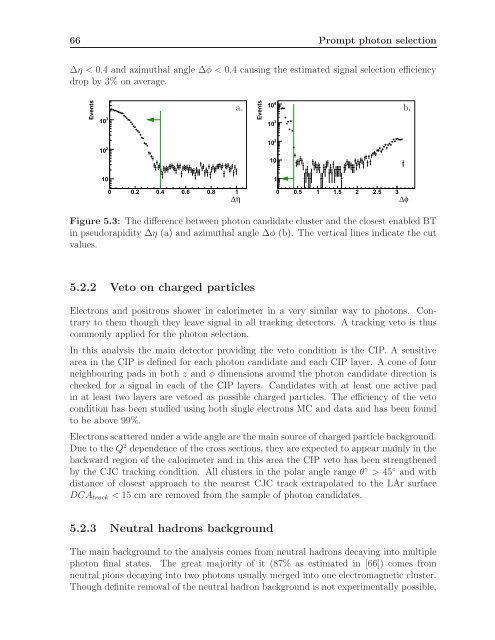10 - H1 - Desy
10 - H1 - Desy
10 - H1 - Desy
You also want an ePaper? Increase the reach of your titles
YUMPU automatically turns print PDFs into web optimized ePapers that Google loves.
66 Prompt photon selection<br />
∆η < 0.4 and azimuthal angle ∆φ < 0.4 causing the estimated signal selection efficiency<br />
drop by 3% on average.<br />
Events<br />
3<br />
<strong>10</strong><br />
4<br />
<strong>10</strong><br />
a. b.<br />
Events<br />
3<br />
<strong>10</strong><br />
2<br />
<strong>10</strong><br />
2<br />
<strong>10</strong><br />
<strong>10</strong><br />
<strong>10</strong><br />
1<br />
0 0.2 0.4 0.6 0.8 1<br />
∆η<br />
0 0.5 1 1.5 2 2.5 3<br />
∆φ<br />
Figure 5.3: The difference between photon candidate cluster and the closest enabled BT<br />
in pseudorapidity ∆η (a) and azimuthal angle ∆φ (b). The vertical lines indicate the cut<br />
values.<br />
5.2.2 Veto on charged particles<br />
Electrons and positrons shower in calorimeter in a very similar way to photons. Contrary<br />
to them though they leave signal in all tracking detectors. A tracking veto is thus<br />
commonly applied for the photon selection.<br />
In this analysis the main detector providing the veto condition is the CIP. A sensitive<br />
area in the CIP is defined for each photon candidate and each CIP layer. A cone of four<br />
neighbouring pads in both z and φ dimensions around the photon candidate direction is<br />
checked for a signal in each of the CIP layers. Candidates with at least one active pad<br />
in at least two layers are vetoed as possible charged particles. The efficiency of the veto<br />
condition has been studied using both single electrons MC and data and has been found<br />
to be above 99%.<br />
Electrons scattered under a wide angle are the main source of charged particle background.<br />
Due to the Q 2 dependence of the cross sections, they are expected to appear mainly in the<br />
backward region of the calorimeter and in this area the CIP veto has been strengthened<br />
by the CJC tracking condition. All clusters in the polar angle range θ γ > 45 ◦ and with<br />
distance of closest approach to the nearest CJC track extrapolated to the LAr surface<br />
DCA track < 15 cm are removed from the sample of photon candidates.<br />
5.2.3 Neutral hadrons background<br />
The main background to the analysis comes from neutral hadrons decaying into multiple<br />
photon final states. The great majority of it (87% as estimated in [66]) comes from<br />
neutral pions decaying into two photons usually merged into one electromagnetic cluster.<br />
Though definite removal of the neutral hadron background is not experimentally possible,
















